FIDE WSTC 2023: USA and Germany Lasker Schachstiftung GK win gold
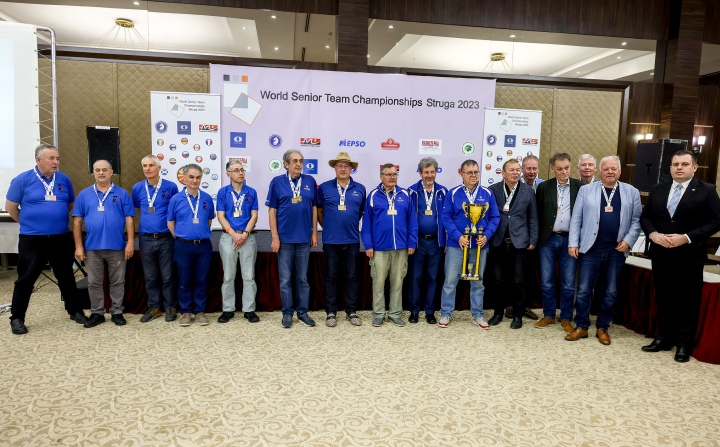
USA and Germany Lasker Schachstiftung GK clinched the titles in S50 and S65, respectively, at the 2023 FIDE World Senior Team Championship. Drama and excitement were dominating the final round of the Championship. At first sight, none of it should have happened, but chess is a sport, and what seemed certain was anything but. The favourites were playing outsiders in the last round, and two of the four leading teams did confirm their status. USA beat Poland 4-0, though not without some luck. Their win was never in question, but the Polish team should have scored at least a draw on board one. Black (Shabalov (2465)) sacrificed an exchange for sufficient compensation. The position is dynamically balanced, and in view of the threat …h4 White should have taken on a6 and then returned the exchange by taking on d6, with a likely draw. Instead, Gdanski (2484) panicked and played 33.Rxf5?? gxf5 34.Kh3 Bc5, losing the bishop on d5. On the other boards, the difference in class was too big in favour of the Americans. Kaidanov (2549) beat Sapis (2375), Novikov (2513) beat Sielicki (1956), and Yermolinsky (2419) beat Flis (1948), none of them experiencing major problems. The drama unfolded on board two in the match between Italy and Montenegro. Italy were co-leaders with USA prior to the final round and, with a win in the match, were guaranteed a silver medal, with gold a possibility depending on the tie-break. Things started well for Italy. David (2523) displayed exemplary technique to win a favourable double-rook endgame against Pajkovic (2412). His win was followed by a win by Godena (2429), who pounced on a big blunder by Podlesnik (2289). The game was balanced throughout, but here, White missed Black’s threat. He played 35.Qe3?? (better was 35.Qe1) Rf1 36.Kh2 Rf2 and the g2-pawn was lost, and with it, the game. On board three Ortega (2410) was winning quickly after the opening. In a King’s Indian, he prepared well and obtained a decisive advantage by move 20 against Miljanic (2331). White had to switch the attack to the f-file with 26.Rf1 Nf7 27.Qf2, winning a piece in view of the tactic 27…Qd8 28.Qxf6! Qxf6 29.Ne8. Instead of that, he played a move dissonant with the dynamic nature of the position: 26.a3?? and after the simple 26…Nf7 Black regrouped and was unexpectedly already winning. White no longer had a breakthrough, while Black was up in material. Miljanic went on to pick up the pawns on e4 and d6 and won the game. This dramatic turnaround proved decisive for the Italian team. Instead of a comfortable victory, they were facing the prospect of not winning the match. At first, it didn’t seem so. Borgo (2333) obtained a winning advantage against Nikac (2275). Here 27…Nxe4 28.Rxe4 Qc5 with the threats of …d3 and …Rf8 was decisive: Black is a pawn up, and White’s king is weak. Black missed this chance, and after 27…a4 28.Bd3 Nxd3 29.cxd3 was only marginally better. In fact, here, he could have forced a draw by giving checks on e1 and d2. That would have won the match for Italy… Completely unnecessary, Borgo transposed the game to a rook endgame where only he could be worse. It was a critical moment in the game. Black had to find the only move 35…Rd5! with the idea of 36.Rxb6 Rf5! cutting off the white king and threatening …Rf2xb2 if the white rook leaves the b-file. Unfortunately for Italy, he missed it, and after a few further mutual inaccuracies, White converted his advantage into a full point. Italy’s draw meant that USA were clear first, winning gold. Now Italy could only hope on their competitors not winning their matches, but they were merciless. England whitewashed the Chinese women’s team China ShenZhen W50 (4-0). It was a dominating performance, as on all four boards, the English grandmasters didn’t give a single chance to the Chinese ladies. In the Exchange Ruy Lopez, Adams (2662) as Black outplayed Liu Shilan (2083). Emms (2448) beat Chunhong Ning (2266) by breaking down Fort Knox in the French Defence. Flear (2405) won a brilliant miniature against Yun Guo (2244), and Davies (2354) strangulated Yanfeng An (2259) on the white side of a Fianchetto King’s Indian Defence. Iceland beat England 2, but it was a tight affair. On board one, a sensation was brewing as Dishman (2304) sacrificed a piece against Olafsson (2491). White played the thematic 10.Nd5! and after 10…exd5 11.exd5 Ne7 12.d4! was already winning, similar to some variations in the Sicilian Defence. Olafsson defended to the best of his abilities, but that would not have saved him had White found the crushing blow in this position. After 28.d6! Nxd6 29.Qe5 White is winning as Black is too disorganized; his king is weak, while White’s rooks dominate after Rad1. White missed this chance, and after the preparatory 28.Rad1? allowed Black to establish a dark-square blockade with 28…Nd6, which helped him save the draw. Neither Hjartarson (2432) against Lewis (2238) on board two nor Arnason (2419) against Clark (2278) on board three could achieve much. The win for Iceland came on board four, but not without luck. Thorallsson (2382) started building up an attack on the kingside against Stebbings (2257). Black’s position was resilient enough, and in the critical moment, he could even have taken over the initiative. White’s last move was 22.Re3, and here Black could have played 22…Nxe5! 23.Rxe5 Qd8! regaining the pinned knight and eliminating any danger. In fact, the position would have transposed to a drawn double-rook endgame after 24.Rh5 Qxf6 25.Qxf6 gxf6 26.Rxh6 Kg7. Black missed this chance and soon came under a strong attack after 22…Rd8? 23.Qe4 (23.Rh3 or 23.Nh5 were even stronger). The position was impossible to defend in a practical game, and White went on to deliver checkmate. This meant that Iceland won 2.5-1.5, but as it turned out, this wasn’t enough – by winning 4-0, England overtook Iceland on a tie-break (board points) and finished second, with Iceland third. On the other hand, it was just enough to edge out Italy by half a point (on tie-break) to secure bronze, as all three teams had
FIDE Trainers’ Online Seminar scheduled for mid-October 2023
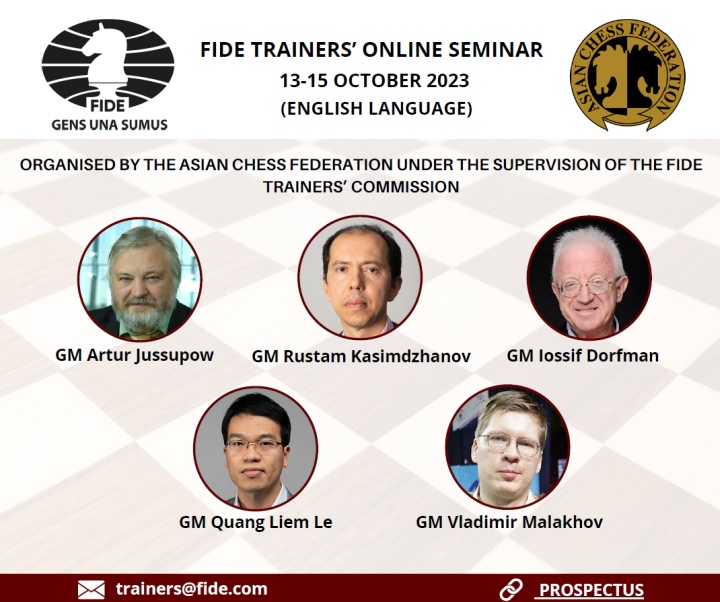
Organized by the Asian Chess Federation under the supervision of the FIDE Trainer’s Commission, the FIDE Trainers’ Online Seminar will stretch from October 13-15, 2023 and cover various topics. SEMINAR PROGRAM & SCHEDULE: DAY & TIME (GMT) TOPIC LECTURER FRIDAY October 13 06:00-08:00 1. Training of Calculation Rustam Kasimdzhanov 09:00 – 11:00 2. Endgame Training.Important Theoretical Positions. Vladimir Malakhov 12:00 – 14:00 3. Introductions, FIDE, TRG and the Trainers System 4. The Roles and Challenges of the Trainers, The Role of the Captains. Artur Jussupow SATURDAY October 14 06:00 – 08:00 5. Positional Play. Recognizing Weaknesses in Pawn Structures. Rustam Kasimdzhanov 09:00 – 11:00 6. Strategy Training. Artur Jussupow 12:00 – 14:00 7. Opening Repertoire/Preparation. Building up an Opening Repertoire. Le Quang Liem SUNDAY October 15 06:00 – 08:00 8.Analyzing Own Games Iossif Dorfman 09:00 – 11:00 9. Dynamic Play in the Opening. Iossif Dorfman 12:00 – 14:00 Written Exam TRG E-Mail Organizer and contacts: FIDE Trainers’ Commission: trainers@fide.com Registration deadline: October 10, 2023 Venue: Zoom Seminar participation fee: €200 Lecturers: GM Artur Jussupow GM Iossif DorfmanGM Rustam KasimdzhanovGM Le Quang LiemGM Vladimir Malakhov Seminar language: English Rules & regulations: trainers.fide.com/trg-online-seminars/
Asian Games: Wei Yi and Zhu Jiner clinch individual titles
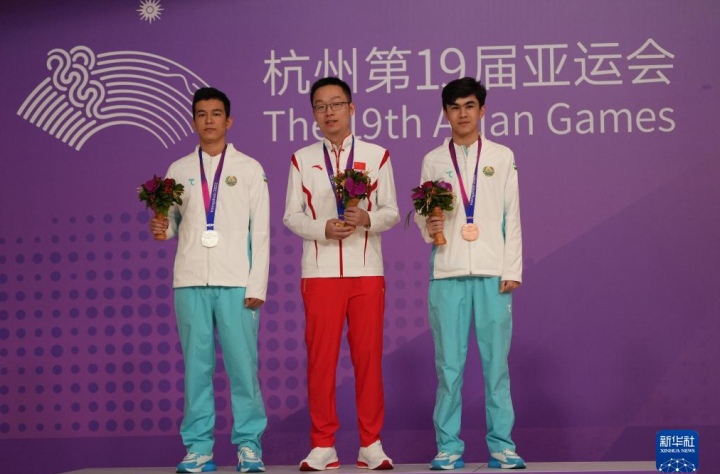
Wei Yi and Zhu Jiner emerged as the winners of the 19th Asian Games chess individual competitions on home turf in Hangzhou, China Both events, 9-round Swiss tournaments with rapid time control, took place from September 24-27, 2023. The men’s tournament was a close race, with top-seeded GMs taking turns at the top of the standings. Suffice it to say that neither of the top finishers completed the event unbeaten. Wei Yi started with a draw but then caught up with the leaders, Nodirbek Abdusattorov and Javokhir Sindarov (both of Uzbekistan) after Round 4. However, after Wei’s loss to Abdusattorov in Round 5, his gold medal prospects looked bleak. Unfazed by this setback, the Chinese GM reeled off four straight victories (including a very important one over the leader, Vidit Gujarathi, in Round 6) to clinch the title with an excellent score of 7.5/9. Nodirbek Abdusattorov (7/9) and Javokhir Sindarov (6.5/9) pulled off crucial wins in the final ninth round to secure silver and bronze, respectively. Final standings men The women’s individual event saw the triumph of Zhu Jiner, who netted 7/9 and took gold. Low-rated WIM Umida Omova made a real splash in the event by finishing second. The 17-year-old from Uzbekistan confidently navigated through a very strong field, scored 6.5/9 and tied for second place with none other than Hou Yifan. The silver went to Omonova thanks to better tiebreaks, while the four-time Women’s World Champion Hou Yifan had to settle for bronze. Final standings women Photos: Han Chuanhao, Xinhua News Agency Official website: hangzhou2022.cn/
FIDE World Senior Team Championship: Day 8 recap
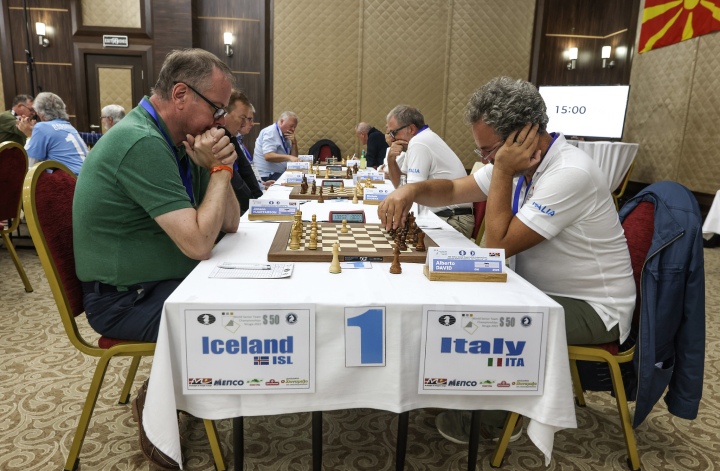
USA and Italy share first place in the S50 coming into the final round, while Germany Lasker Schachstiftung GK need just a draw in their last match to clinch the title. The penultimate round saw the favourites win their matches, and the derby on board one ended in a draw after a couple of unexpected results. Iceland faced Italy in a direct duel for the leading spot. The first game to finish was the draw on board three between Arnason (2419) and Ortega (2410). Ortega surprised his opponent with the choice of the Cordell Variation in the Ruy Lopez (1.e4 e5 2.Nf3 Nc6 3.Bb5 Bc5) and easily equalised. Moreover, he continued with confident play and obtained an advantage. The only mistake Ortega made was to accept a draw in an advantageous position. Black accepted a draw here, but it’s a risk-free position for him, and he should have continued the game, for example by 23…Qb7 24.Bb3 Bf5 when it’s clear that Black is more active. This draw could have easily made all the difference as soon enough, Thorallsson (2382) beat Bellia (2388) with the black pieces. In the Classical Sicilian, Bellia chose the Rauzer Attack, but it was Black who sprung the real surprise. In this fairly standard position, Black played the surprising 12…0-0-0!?. The move has been tested in several correspondence games with good results for Black. After the careless 13.h5?! (White had to take some measures against the threat of …d5) d5! Thorallsson already took over the initiative. Soon enough, it was Black who started an attack on the queenside, and he crowned it with a nice sacrifice. Black crashed through with 26…Rxd3! 27.cxd3 Bxb2 since the bishop cannot be taken in view of …Rb6 and …Qe5, mating, while 28.Kb1 Rb6 only prolonged the agony. At this point, the match seemed to be going in Iceland’s favour. The position on board two was drawn, and on board one, they had an advantage. A drawn position doesn’t always mean that the game will end in such a result. Godena (2429) didn’t get anything out of his favourite Alapin Sicilian against Petursson (2396), and the game slowly but surely was going towards a draw. The endgame should lead to that result with reasonable play by both sides, but something happened, and Petursson started to make strange moves. He allowed White to get the king to c4 and push b4. Suddenly, things were not easy anymore. Here, Black should have started counterplay on the kingside with 32…h4, with the idea to reduce the material there. Instead, he went for the very passive 32…Nd8? and after the natural 33.b4 White was close to winning! After the exchange of pawns on b4 it was a last chance for Black to play …h4, but he missed it, and once the pawn marched b5-b6, White had a winning advantage, which he converted. A victory for Italy almost out of nowhere! With the match tied, everything was to be decided on board one. Hjartarson (2432) seemed more patient than David (2523), who found himself under pressure soon after the opening. He saw no other way out but to sacrifice two minor pieces for a rook and a pawn. However, it was clear that the minor pieces were much stronger. White untangled with 23.Qc4 and started moving forward with Nf4. Both players committed imprecisions as the evaluation swung from better for White to better for Black, but after the time control, it became apparent that White consolidated the position. White went for 43.Nb2-c4, eyeing the d6-square. Black’s problem was that his rooks lacked open files and David tried to do something about it with 43…g5, followed by …Kg8 and …Rg7. White is winning, and the simplest way was to exchange the bishops with 46.Bf3, as White’s bishop is not very active, while Black’s is on a very solid square. White, however, went for 46.e5 but this only helped Black as it opened files for the rooks. After 46…fxe5 47.Ndxe5 gxh4 48.gxh4 Bd1! Both rooks were very active on open files. White was no longer better, but keeping in mind his game from the previous day, when he squeezed a win against Georgiev in more than 100 moves, Hjartarson kept pushing, as he knew that a win would win the match for his team and give them the lead heading to the final round. This time, he went too far with it. After massive exchanges, Black’s remaining rook broke free and started going after White’s weak pawns. The knights are notoriously bad at dealing with passed pawns on a or h files, and here Black was getting a passer on the a-file. It was now White who needed to save the draw. The position was not easy to play for both sides, but more difficult for White, who needed to find a way to deal with the passed a-pawn and also with the threat of losing the h4-pawn. Hjartarson decided to bring the king to the queenside, but here 57.Kd2? was a losing mistake. It was better to take on c6 and engineer counterplay with the passed c6-pawn. After 57…Rh3! Black was winning, but it was not simple. With very little time on the clock, David went for the safety-first move 60…Rc3, eliminating the dangerous pawn on c5. Instead, 60…Rxh4! 61.Nxc6 Ra4 62.Ka1 h4 was winning for Black. As played, White took on a2 and brought the king to b3 to secure a draw. A truly topsy-turvy match that could have gone either way! In the end, perhaps a draw was a fair result, which kept Italy one point ahead of Iceland. The other favourites won relatively easily. USA routed Uruguay 4-0. It was hardly surprising outcome as their rating advantage on all boards was several hundred rating points. Kaidanov (2549) beat Braso (2058) in a technical manner in a Catalan. Ehlvest (2530) executed a mating attack against Escofet (1902) in a French-like position arising from the Modern. Novikov (2513) easily refuted Barandiaran’s (1897) Polish Defence, and Yermolinsky (2419) overtook the initiative in a Sicilian after Barboza’s (1777) passive approach. England 1 beat Montenegro 3-1, thanks to victories on the first two boards. Adams
Carissa Yip takes the sole leadership in World Juniors
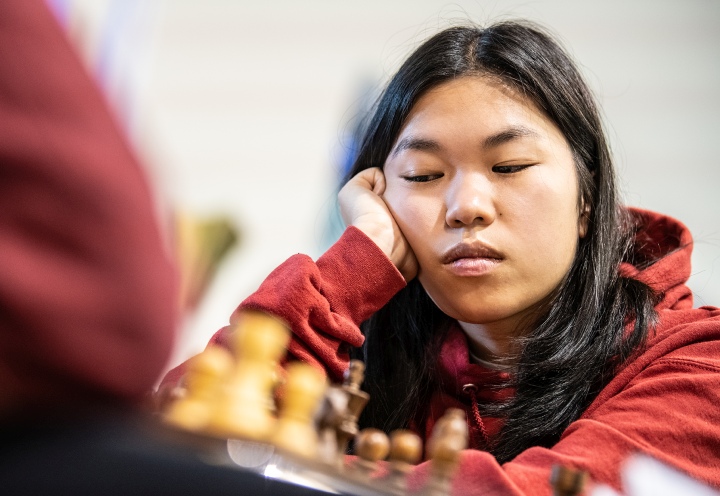
Carissa Yip is now the sole leader of the World Girls Junior Championship in Mexico after defeating Ravi Rakshitta with the black pieces. The game was a Kraumer variation of the King’s Indian, where white went for a rare move, 10.Bg5. It was precisely this bishop that would cost Ravi the game, as she gave it up (or straight away blundered it?) for little compensation nine moves later. Nevertheless, the way Carissa exploited her opponent’s mistake was truly beautiful, with her rook and knight combo completely dominating the White pieces. With this victory, Carissa became the first sole leader in the Girls’ event on 5.5/6, having defeated her two direct rivals, Mariam Mkrtchyan and Ravi Rakshitta, in consecutive rounds. After the setback in round 5, the Armenian returned to her winning ways with a very fine victory against the young Miaoyi Lu. The Chinese prodigy, with black, placed her Queen on a8 to reinforce her pressure along the long diagonal to counterweight her opponent’s Catalan bishop. However, as soon as some black pieces blocked the diagonal, the Queen found itself misplaced and far from the action, and Mkrtchyan took advantage of this fact in a masterful way, scoring a very valuable point and bouncing back from her 5th-round defeat in very convincing fashion. Sofiia Hryzlova, from Switzerland, and Beloslava Krasteva, from Bulgaria, also won in Riybd 6 and are now chasing the leader with 5/6, while Candela Francisco and Barbara Goraj drew their game on board two, which leaves them with 4.5/6. Yip, Goraj and Krasteva have been undefeated in the competition so far. In the open section, Marc Andria Maurizzi drew with the black pieces against Elham Amar of Norway. Meanwhile, five of his sixteen pursuers scored victories to catch up with the leader. For the first 15 moves, the game followed a well-known variant of the Petroff that has been played by many top GMs, but Elham deviated from known theory with 16.Bh3, which drastically changed the position. However, after the exchange of rooks, the game was completely equal, and the players split the point – probably a satisfactory result for them both. On board two, Jan Subelj obtained some initiative against Hans Niemann’s Sicilian, but objectively speaking, he never had an advantage, and the game ended in a draw by perpetual check after 36 moves. The same result was reached in the game between Arseniy Nesterov and Luka Budisavljevic after very solid play from both parts in a closed Catalan. The first decisive outcome was registered on board four, where Ruben Koellner defeated Rudik Makarian with White in a rare line of the London System. The German won a pawn in the opening and converted his advantage by weaving a lovely mating net with his rook and knight. Andy Woodward lost, with White, to Gleb Dudin, who moved to 5/6, unbeaten. Despite this setback, the hopes for the 13-year-old American to achieve a GM norm are still alive, as he is still on 4/6 and gaining 6 rating points. Maurizzi, Pranav, Dudin, Koellner, Dushyant and Santiago Avila are now all tied in first place with 5/6. The main pairings for the seventh round are Maurizzi – Pranav, Dudin – Koellner and Dushyant – Avila, all with 5/6 in the open section. In the Girls’ competition, the leader, Yip, will have white against one of the tournament’s revelations, Sofiia Hryzlova (pictured above) of Switzerland, while Krasteva will face Mariam Mkrtchyan on board two. Standings after Round 6: OPEN GIRLS Written by David Llada Photos: David Llada Official website: juniorchesschampionship.fenamacajedrez.com/
FIDE World Senior Team Championship: Day 7 recap
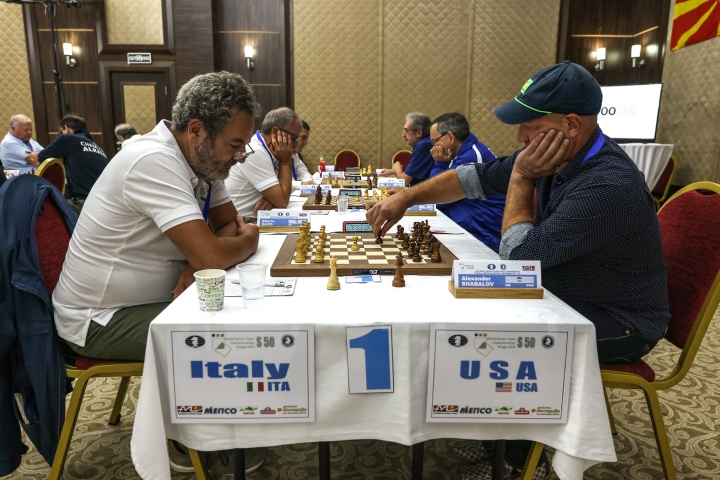
Italy beat USA to take over the top position in the S50; Germany Lasker Schachstiftung GK is unstoppable in the S65 section. The seventh round brought some unexpected results in the S50 section and very expected results in the S65 section. Italy scored a very convincing victory over USA. As the match went on, the American team didn’t even stand a chance. On board one, David (2523) demonstrated his attacking prowess and demolished Shabalov (2465) in mere 29 moves. Black’s position was already bad, but his last move 21…h6, only provoked the crashing 22.Nxf7! Qx75 23.Qg4 Kg7 24.f5! and the curtain fell just five moves down the road – 1-0. On board three, Ortega (2410) choked off Novikov (2513) in a hedgehog where, at first sight, it appeared that Black was quite alright, in view of White’s atypical placement of the pieces. It turned out however that it was a very effective setup. After 16.e5! dxe5 17.Bxe7 Nxe7 18.Nxe5 White’s initiative became too strong to contain, and Ortega didn’t allow his opponent even a single chance, winning in 36 moves. On the boards where USA was playing with the white pieces, Ehlvest (2530) couldn’t do much against Godena’s (2429) Queen’s Gambit Accepted and Yermolinsky’s (2419) misplacement of the rooks in the middlegame in the Catalan meant that he was the one fighting for equality against Bellia (2388). An impressive and dominating match for the Italian team that stepped up when it mattered most. With this victory, Italy took over the lead from USA and how sits alone at the top of the standings with 12 points. In the match between Iceland and North Macedonia Alkaloid, the first victory was scored on board three, where, in a very sharp position Bogdanovski (2385) blundered against Arnason (2419). White doesn’t really threaten much on the kingside, so Black had a chance to start his own play on the queenside with either 29…b4 or 29…Qc2. Instead, he played a defensive move 29…Rd6? which allowed White to push 30.h5, creating a real threat g5-g6. In time trouble, Black went for what looked like a simplifying sequence, missing that after 30…fxg5 31.Rfxg5 Ne3? 32.Bxe3 Qxe3 33.Qxe3 He cannot recapture on e3 in view of the mate on g8. 1-0 A balanced draw on board four between Stanojoski (2351) and Thorallsson (2382) followed before Nedev (2465) equalised the score with a win over Petursson (2396). The game was one-sided, as Black couldn’t recover from the bad opening choice he made early on. In this well-known Najdorf position arising from the line with 6.h3, Black went for the very dubious 8…d5? which led to a bad endgame after 9.fxe5 Nxe4 10.Nxe4 dxe4 11.Qxd8 Kxd8 12.Bf4. Black had problems with the pawn on e4, and while he tried to defend it with tactical means, eventually, White emerged with an extra pawn, which he converted without much trouble. With the match tied, everything depended on the result on board one. Hjartarson (2432) and Georgiev (2542) reminded us of the famous Karpov-Kasparov duels in the Classical Scheveningen. The position remained balanced for a very long time, but it was notable that Hjartarson avoided possible repetitions and kept the game going. Black should have just bided his time with 57…Qe7, for example, but he lunged forward with 57…f5? Most likely, this decision was based on miscalculation, as White could have taken the pawn on f5, either with knight or queen, which would have given him a winning advantage. However, it appears that both players were under the impression that the pawn shouldn’t be taken. The game went 58.b6 (also good) Qf6 59.Nc6? (instead of the winning capture on f5). Now Black should have played 59…Qg5, but he probably missed the drawing combination: After 59…Qg5! 60.b7 Nxb7 61.Rxb7 Rxg2! 62.Qxg2 Qh4 leads to a perpetual check. Georgiev chose 59…Qf7?! which resulted in White’s winning a piece after 60.Nd8 Qxd5 61.Qxd5 Rxd5 62.b7, but the ensuing endgame should still be a draw. White managed to win Black’s d-pawn, though it shouldn’t have sufficed. Play continued for a very long time, and the critical moment arose on move 101. White created the threat of bringing the knight to f5. Black had only one way to stop that – 101…Rb3! with the idea to pin the knight after 102.Kf4 Rb4!. Georgiev either missed White’s idea or his best defence and played 101…Re3? and after 102.Kf4 Rb3 103.Ng3, the knight was coming to f5. The game finished with a neat two-move combination. 109.Rxg7+ Kf6 110.g5+! Black resigned in view of 110…Kxf5 111.Rf7 when the rook on f1 is lost. 1-0 A dramatic win for Iceland, who are now sharing second place with USA, one point behind the leaders, whom they face in the penultimate round. In the duel of the two English teams, England 1 beat England 2 by 3-1. Adams (2662) outplayed Dishman (2304) on board one, the game ending in a pretty checkmate. White wrapped up the game with 37.Nc5 Rb4 38.Bf8 mate 1-0. What happened on board two was some sort of a mystery. After both players followed theory until move 13, Lewis (2238) chose the rare and not-very-good 13.Nf3?! instead of the theoretical 13.Qa3. After Flear (2405) replied with the natural 13…c5, White had a hallucination. Lewis played 14.Ng5?!? and after the simple 14…Qxg2, with a double attack on the rook on h1 and the knight on g5, the game was practically over. White resigned six moves later. The other two games Arkell (2352) – Clark (2278) and Stebbings (2257) – Davies (2354) were drawn without much hassle. This win allowed England 1 to stay in contention for the medals. Since they have already played all the strong teams, they can now expect weaker opponents in the last two rounds. In the S65 section, the usual suspects kept on winning. Germany Lasker Schachstiftung GK beat France 3-1 thanks to wins with the white pieces on boards one and three. The finale on board one was notable. Knaak (2438) was winning for some time, but there was no real need for Legky (2357) to blunder into a mate in one (!) with 34…Qf7?? 35.Qd6 mate. On board three, Kalintschew (2377) crowned his positional domination against Boudre (2245) with an effective exchange
Maurizzi, Rakshitta and Yip lead FIDE World Junior Championship
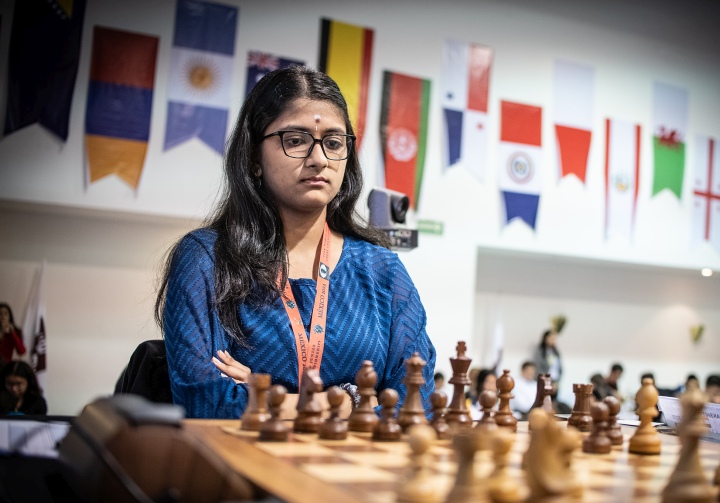
The main excitement in the 5th round of the FIDE World Junior Championships came from the Girls’ tournament, where WGM Carissa Yip made quite a statement beating IM Mariam Mkrtchyan. The Armenian had won all her 11 games at the World Championship U18 last year, and the first four games here in Mexico, but her fantastic run came to an end today. The aggressive and tactical style of the players immersed us in a chaotic game where both strived for the win. The American came up with an interesting novelty, 8.f3. A key moment in the game was the advance 16.f4?! by Carissa, which gave Mkrtchyan a clear advantage, not with just one, but several different answers. However, the position remained very double-edged, and both players made their share of inaccuracies. The Armenian missed several tactical blows that would have been decisive, and somehow allowed her opponent to survive and advance not just one but two of her pawns to the 7th rank, allowing Yip to get away with one of the biggest swindles in the competition so far. The other decisive result on the top boards came in the game between Alessia-Mihaela Ciolacu and Ravi Rakshitta. Just when the Romanian had achieved a clear edge, around move 29, she made a couple of mistakes that allowed Rakshitta to get the pair of bishops and open the position in her favour. The fatal mistake was 53.Nxc5?, a move that tied the White King to the defence of the Knight. A fine swindle too by Rakshitta, who comes from chess-playing parents with international titles and several medals at national and regional championships. She will have the White pieces against Carissa Yip in the sixth round against her co-leader, in a game that could be decisive for the final victory. In the open category, French Grandmaster Marc’andria Maurizzi continues to lead. He drew, with the White pieces, against Arseny Nesterov, in a very correct but not-so-exciting game. ”It was a solid game where there were no combat opportunities”, summed up Nesterov in the post-game interview. This result was good enough for Maurizzi to continue leading, as all the games in the top seven boards ended with the same result. He is followed by no less than 16 players with 4 points; among them, the Americans Hans Niemann and Andy Woodware, who won their round 5 games, as well as Latin American Santiago Avila Pavas. Monday 25 will be a rest day, and most of the players will take an excursion to the Pre-Hispanic City of Teotihuacan, some 50km northeast of Mexico City, to visit the pyramids. Built between the 1st and 7th centuries A.D., this archaeological site is characterized by the vast size of its monuments – in particular, the Temple of Quetzalcoatl and the Pyramids of the Sun and the Moon. Play will be resumed on Tuesday, at 16:00 local time (-7 GMT) Standings after Round 5: OPEN GIRLS Written by David Llada Photos: David Llada
Chess for Protection: Two years and counting
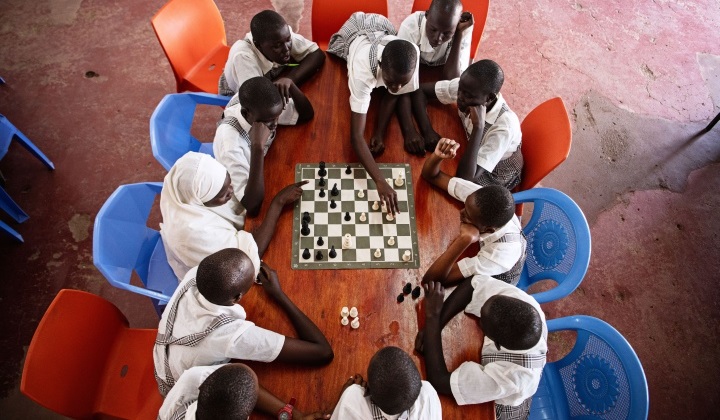
The game of chess greatly benefits society, as it offers people the opportunity to reach their full potential, regardless of their background, by gaining self-confidence, experiencing social integration and learning valuable life skills. It is the primary aim of the Chess for Protection project, implemented in collaboration with the International Chess Federation, UNHCR, the UN Refugee Agency, the Lutheran World Federation (LWF), the Kenya Chess Federation and the Kakuma Chess Club. The program, launched in August 2021, consolidates and develops chess-related activities in Kakuma Refugee Camp in Kenya. It is now entering its third year of running. A chance to heal, develop and grow “In FIDE, we really believe that chess is more than a game; it is a tool to improve the so-cial environment for millions of people. Kenya has the second biggest refugee camp and the third biggest slum in the world. Over 55% of the refugee population here are children and adolescents. Chess as a part of the extra-curricular activities will undoubtedly contribute to the well-being of youth, their psychological needs and their development. FIDE thanks UNHCR, LWC and Chess Kenya for their support in carrying out this very important social project,” says FIDE President Arkady Dvorkovich. Forced to flee their homes, the refugees are exposed to extreme stress that may impact their psychosocial well-being. Most of them are not engaged in any income-generating activities, which leaves them vulnerable to risks of being involved in dangerous behaviour – crime, violence, drugs, and gang activities – as a means for coping with the situation. That is why it is critical to ensure youth are engaged in meaningful activities where they have a chance to heal, develop and grow. And chess can help with this. “This is not just about chess; it’s about giving dreams to children and youth. This is particularly important when it comes to the lives of people in vulnerable situations. There’s strong evidence that chess increases analytical skills, self-esteem and the understanding between the cause and the consequence. Besides, it teaches not only how to win but also how to cope with defeat. Pupils attending chess classes are not only experiencing self-improvement and self-growth, they also bring enthusiasm and inspiration to their communities, acting as agents of positive changes there,” says Dana Reizniece-Ozola, Deputy Chair of the FIDE Management Board. Over the last two years, more than 2,000 refugees were introduced to chess, 36 chess clubs were established in Kakuma refugee camp and Kaloboyei settlement, over 350 chessboards were bought for these clubs, 21 facilitators were trained and are now teach-ing chess in the region, as part of the Chess for Protection project. Besides, FIDE provided fourteen bicycles and one motorbike for the mobility of those trainers. It did not take long to see the results of such efforts. “I’ve supported the project since August 2021, and it’s been such a rewarding experience for me. The chess program is having such a positive impact on the lives of the students – they are concentrated and focused at school, and they are competent problem solvers – all of them are becoming better students because of their participation in the chess group,” says Ina Guya, Protection Associate in Kakuma refugee camp. “Through the series of games and tournaments, the players have learned to manage their emotions, handle wins and losses gracefully, and cope with frustration when things don’t go as planned.” Women’s empowerment through chess In parallel with training the youth and kids in Kenyan schools, FIDE focuses on empowering young females and girls. Many of them find it difficult to meaningfully engage in education and extra-curricular activities due to negative cultural norms that often prevent them from equal access to opportunities. Chess for Protection project includes activities of the Girls Club, where, apart from playing chess, club members are meeting and communicating with successful women, reading and discussing books, attending painting workshops and many other classes. Spearheaded by Anastasia Sorokina, Chair of the FIDE WOM Commission, the project was first launched in 2021 in Angelina Jolie Primary School in Kakuma with an attendance of 40 students. After two years of running, it now includes three girls’ boarding schools in the region – Angelina Jolie Primary School, Morneau Shepell Secondary School and Bhar-El-Naam Primary School – with 250 refugee schoolgirls having chess classes twice a week. “When we embarked on this adventure, our goals were clear: to introduce chess to young girls and foster their creative development. And we are on the way to achieving that and so much more,” says Anastasia Sorokina. Female students attend online lessons by WGM Anastasiya Karlovich (UKR) and IM Salome Melia (GEO). They also study and play chess with a local tutor. “We started with groups of girls who may not have known what chess was, but they embraced the opportunity to learn with open hearts and minds. Week by week, they learnt little by little, from how to move pieces and set up the board to the more complex strategies. Their determination to improve their personal chess skills was truly inspiring,” says IM Salome Melia, chess trainer of the Girl Club Project. “We have had the pleasure of getting to know these girls and seeing their progress and growth of self-esteem and confidence. Their determination and positive attitude demonstrate that chess is not just a game; it’s a powerful instrument of transformation, a gate-way to a world of endless possibilities. The progress these girls have made fills us with happiness, and we can’t wait to see them in Kakuma in person one day,” adds another chess trainer, WGM Anastasiya Karlovich. For some of these girls, chess is just a tool to improve their school performance, problem-solving, and analytical skills; others wish to become professional chess players. “I have learned how to play chess in my school club, and I really like the game. It helps me a lot in my everyday life, improving my thinking and behaviour. It is not so easy to learn the game, but I see the progress all the time. I like to play with
FIDE World Senior Team Championship: Day 6 recap
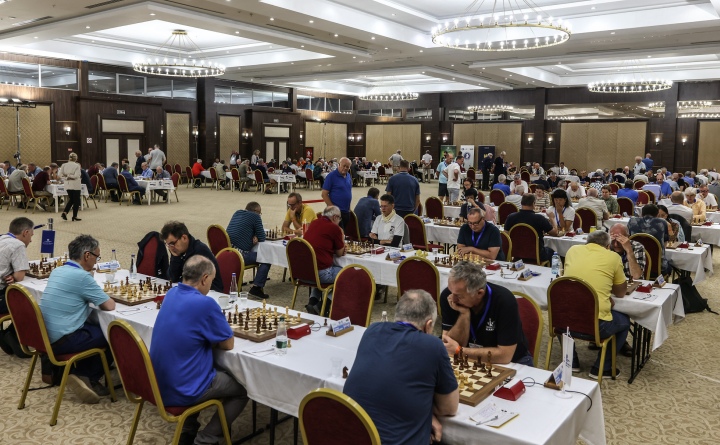
USA grabs the lead in S50; Germany Lasker Schachstiftung GK tops the standings with a perfect score in the S65 section. In Round 6, the number of draws remained the same, but what increased was the number of blunders. In the duel of the leaders, USA and Iceland, both on 9 points, the Americans made solid draws with Black on boards two and four, Kaidanov (2549) drawing Petursson (2396) and Yermolinsky (2419) drawing Thorallsson (2382), but this didn’t mean that their players with the white pieces had everything under control. True to his creative style, Shabalov (2465) found ways to unbalance even the slow and strategic Chigorin Variation of the Ruy Lopez. However, Hjartarson (2432) was up to the task, and the complexity of the position made the evaluation swing drastically. Both players missed chances, but none too obvious. Here’s the last moment in the game when Black could have won. The mess is obvious. White’s last move. 41.Ne3xf5 was a mistake. Better was to play 41.Rcg1, but even there, the position continues to be extremely complicated. In the position on the diagram, Black should have taken on f4 (instead of g6 as in the game) and after 41…Bxf4! 42.Rg4 Bxc1 43.Ne7 Kg7 44.gxh7 Kf7 45.Ng8 Bb2! manages to stop the h-pawn from promotion. In spite of being a full rook down, White can continue to create problems with 46.Bg6 Kg7 47.Be4 Kh8 48.Ne7, etc., but objectively Black should win. By taking on g6 Black allowed a pretty and very unusual construction that forced a perpetual check. White’s last move was 44.Bf5 and after Black took the rook, White gave perpetual with Nc8-d6. A unique harmony of the white pieces! The decisive win was scored by Ehlvest (2530) on board three against Arnason (2419) in another Ruy Lopez. White obtained an advantage after the opening in which Black missed an important zwischenzug and from then on, it was a game with only two results possible: a win for White or a draw. Ehlvest was not always very precise, letting his advantage slip away, but that was never obvious, and Black failed to make the most of his chances. The critical moment was just before the time control. White has just played 39.Bc3, threatening Qf6. Black’s only move was 39…Ne5, but he vacillated for one move too long with 39…Qd7? after which 40.Qe4 (40.Qh3 was even stronger) followed by Qd4 led to White soon winning a pawn. The rest of the game was exemplary, with the final zugzwang illustrating the domination of the bishop over the knight. Black chose 67…Nb1 and lost the knight after 68.Be3 and Kb2, but going to b5 wasn’t much better, as after 68.f4 Kb7 69.Kc4 Ka6 70.Kb4 Black ends up in a lost pawn endgame as the knight has no moves. An extremely important win for the USA, now leading the event as sole leaders. The match between Italy and Austria was riddled with blunders. The first game to finish was on board four, where Denk (1581) didn’t really have to lose in mere 7 (!) moves to Borgo (2333). White didn’t play the opening too well, but there was no need to play 7.Bb5?? After 7…Qa5+ Black won the b5-bishop. Denk resigned. Soon after, Opl (2151) blundered against Bellia (2388). Instead of the normal 19…Kh7, defending the pawn on h6, Black went for a “combination”. He played 19…Qf6? and after 20.Bxh6 Bxh6? (sticking to his plan) 21.Qxh6 delivered his shot 21…Bxh3, missing however 22.Ng5, both threatening with checkmate on h7 and attacking the bishop on h3. Naturally, Black resigned. On board two Ortega (2410) perhaps thought that the Austrians had been too kind. Against Druckenthaner (2182) he had the advantage, but misplayed it and reached the following position. After 35…Rxa5 36.Rh8 Kg7 37.Rxe8 Nxd5 Black should draw, but instead, he chose the suicidal 35…Ra8?? 36.Rh8 Kg7 37.Rxa8, which left him a full rook down. The stabilising presence on board one was Godena (2429), who managed to draw from a winning position a full exchange up against Denk (2186). It should have been a convincing win, but even a minimal one would do for the Italians, who are now second, only a point behind USA. The match between North Macedonia Alkaloid and England 1 was no less dramatic. On board one Adams (2662) seemed to surprise Georgiev (2542) in the opening and quickly took the initiative with the black pieces. The initiative was transformed into an extra pawn that Michael carefully nurtured to a win in 60 moves, without allowing his opponent a single chance. There were two relatively calm draws on boards two and four, where neither Emms (2448) could pose serious problems to Bogdanovski (2385) nor Davies (2354) could create much against Kutirov (2274). All the drama unfolded on board three in the game between Stanojoski (2351) and Arkell (2352). Playing his favourite Caro-Kann, which was met by Stanojoski’s favourite Exchange Variation, Arkell was fine after the opening, but allowed White to expand too much on the queenside. Then it was White’s turn to mess things, and he did so badly. The knight jump to e5 was bad as after the exchange there Black now played 25…Rc3! The queen had to go to f4 since 26.Qd2? Rg3 loses. After 26.Qf4 f6! 27.Bb8 Rcc8 suddenly the bishop was trapped on b8 and Black was a clear piece up! Stanojoski continued as if nothing had happened and Arkell started to play passively, moving his pieces to the last rank. He was still winning, but it was obvious that he wasn’t getting closer to victory. Then, just before the time control, he blundered all of his advantage. Instead of 38…Qf8 or 38…f5, he played 38…Be4? (which was good some moves earlier) and after 39.Bxe4 dxe4 40.a5 all of a sudden, White was not lost anymore! The activity of White’s pieces, the passed a-pawn and the passivity of the black pieces balance each other out. Arkell continued to play with a great degree of hesitation and soon enough blundered again. Here, probably the simplest was 44…Rf8, avoiding any tricks based on Rxf6, but moves like 44…Kg7 or 44…Rc1 were fine too. Instead, after 44…Rc7? 45.Rb6! with the threat of Rb7 White was winning! Probably in a state of
World Junior Championship U20: Maurizzi and Mkrtchyan, first sole leaders after four rounds
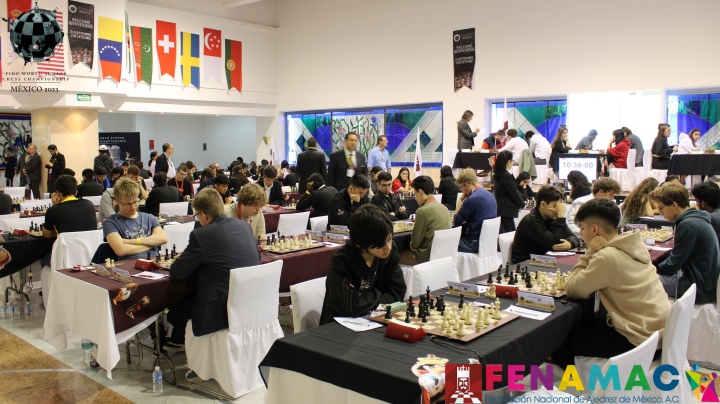
After three days of play and four rounds, GM Marc’Andria Maurizzi (France) and WIM Mariam Mkrtchyan (Armenia) have emerged as the first sole leaders at the FIDE World Junior Championships in the open and girls’ sections, respectively. They are the only players with a perfect score of 4/4. In a field that includes a total of 14 GMs and 29 IMs, the main favourites in the open were the top-seeded GM Hans Niemann (2667), from the USA, and German GM Frederik Svane (2626). Two other serious contenders are GM Anand Pranav (2509), the current U-14 world champion, and the 2022 World Champion U-18, the Canadian IM Shawn Rodrigue-Lemieux (2485). Also notable is the presence of young chess players such as the 14-year-old American IM Andy Woodward and the Colombian Andres Garzon (2144), who is just 12 years old. The first two rounds were smooth sailing for the top seeds, winning their games with relative ease against lower-rated opponents. The first upset came in round three when GM Hans Niemann (2667) was defeated in a compelling way by his compatriot, the 13-year-old American IM Andy Woodward (2480), the youngest titled player in the field. Woodward demonstrated superb preparation for this game and played a relatively new idea against the English opening, previously used by Daniil Dubov, which involves a pawn sacrifice on e5. In this position, although White is slightly better in theory, Black has a strong initiative and it is not easy for White to find the right path. And that’s exactly what happened: on move 21, an inaccurate move by Niemann led to his loss. IM Woodward couldn’t hide his enthusiasm and ambition at the end of the game. “I am definitely very happy, and I will continue fighting all the games until the end, without giving up”, he said in this interview. He also mentioned that he already has two GM norms, and his goal is to achieve the third one in this event, besides earning some rating to close the gap to the 2500 threshold required to get the title. Another interesting result was the draw achieved by the highest-rated Mexican player in the field, IM Sion Galaviz (2462), who drew against the Indian GM Anand Pranav (2509). The games became much closer in round four, where the strongest players began to cross paths. Some well-fought games ended in a draw on the top boards, like the ones between GM Ruben Koellner (2485) and GM Arseniy Nesterov (2575), the Colombian GM Santiago Avila (2510) and American IM Kirk Ghazarian (2473). In the co-leader clash after day two, French GM Marc’ Andria Maurizzi (2555, pictured below) won his game, beating the previous day’s hero Andy Woodward (2480). In the Girls’ category, the course of the event followed a very similar script, with the main favourites imposing their better play against their opponents in the first three rounds. One of the few upsets was a half-point conceded by current American Continental Champion, WGM Candela Francisco (2345), who was held to a draw by WIM Zeinep Sultanbek (2022) from Kazakhstan. The top seed, Carissa Yip (Elo 2372), won her first three games, but in the fourth round, she had to settle for a draw against WFM Tatyana Getman (2172). The American prodigy didn’t get anything from the opening, a King’s Indian, and after the queens’ exchange, Carissa opted to go for a line that forced the draw by threefold repetition. This result allowed WIM Mariam Mkrtchyan (pictured below) to become the first sole leader of the event, as the Armenian won her game with White against WIM Sofiia Hryzlova. It was a close battle, but at some point, Sofiia decided to sacrifice a pawn to open lines against the enemy king but did not get enough compensation. Mkrtchyan was ruthless in converting her advantage, and she won her fourth straight game, the result that reminded of her dominant performance at the World Championship U-18 last year in Mamaia, where she became the winner with an astonishing score of 11 out of 11. The Girls’ category also includes some young prodigies that so far have left a very good impression with their play: 8-year-old Romi Milner (1856), from the USA; the Pan American Champion, 10-year-old Mia Guzman (1753) from Mexico; and 14-year-old WIM Miaoyi Lu (2214), from China. The most interesting clashes in Round 4 are Marc Andria Maurizzi (4) vs Arseniy Nesterov 2575 (3½) and Rudik Makarian (3½) vs. Anand Pranav (3½), while Hans Niemann (3) will take on GB Harshavardhan (3). In the Girls’ section, Carissa Yip (3½) will have White against Mariam Mkrtchyan (4), a matchup that has all the makings of a stellar duel, while on board two, the young prodigy Miaoyi Lu (3½) will face the much more experienced Candela Francisco (3½). The 5th round begins at 16:00 local time (GMT-7). Written by David Llada Photos: official webste and David Llada Official website: juniorchesschampionship.fenamacajedrez.com

